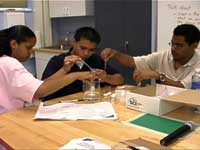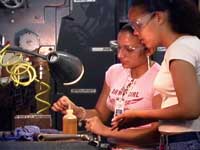

New Jersey Students Work
to Fly High with NASA This
Summer
Recently, four students from Williams L. Dickinson Technology
Magnet School, a technology-focused high school in Jersey
City, traveled to the Johnson Space Center in Houston,
Texas to both work and observe as an experiment they
designed is carried out in a near-weightless environment.
The students, Carlo Fajardo, 15, Humberto Guzman, 15,
Jennifer Rodriguez, 16, and Denise Salinas, 17, who were
selected based on merit and success on pervious science-related
projects, have been working with their teacher Howard
Zlotkin, NASA scientist Greg Vogt and Liberty Science
Center educator Rosa Catala to develop the unique experiments.
The experiments will be performed aboard a NASA KC-135,
a plane that performs a series of sweeping arcs at about
38,000 feet in the air to create short periods of near-weightlessness.
After a rigorous selection
process the group selected two projects to test onboard
the KC-135. The first, “Effects
of Micro-gravity on Bioluminescence,” will show
if there is any change in the chemical reaction that
produces bioluminescence in a near-weightless environment.
Bioluminescence is the light produced by the chemical
reaction inside the body of a living organism. Viewing
the reactions that take place during a number of test
flights will complete the experiment. The research will
be done in an experiment chamber consisting of two boxes.
The primary box is where the actual experiment will take
place; the second is the storage where the replacement
vials will be.
The second, “Whoa Roaches,” will
test the effects of micro gravity on the sensory area
of Madagascar hissing cockroaches.
During these sessions, students will learn about the
scientific process, Micro G and space, with activities
conducted to promote cohesiveness and teamwork. Additionally,
Liberty Science Center staff scientist Dr. Betty Faber
visits the students twice a month to discuss aspects
of biological processes and how scientists plan and conduct
research.
Since March the students have
been visiting Liberty Science Center on a biweekly
basis to utilize the center’s
unique resources and to learn more about their project
parameters through special activities designed to enrich
and support their classroom curriculum.
This program is the first component of a unique collaboration
between Liberty Science Center and NASA, designed to
bring the excitement and challenge of science to students,
teachers and families through a wide variety of community
activities that can be held at Liberty Science Center,
then replicated at science centers and museums across
the country.#
